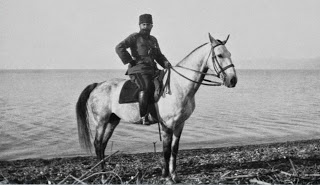
The story of how the Ottomans expelled thousands of inhabitants of Tel-Aviv-Yafo in 1917 is one Israel would rather forget. Nadav Shragai of Haaretz reports in an article first published in April 2007(link no longer available):
Ottoman military governor of Syria Jamal Pasha
“In a section on the outskirts of the Yavne’el cemetery lie dispersed dozens of basalt tombstones, without names. Only one is engraved with a few clear lines, recounting a terrible tale that nearly disappeared into oblivion: “In memory of my dear parents, Yaakov and Creina Klein (Keter) aged 35-38 and my brother Yehoshua Yona (z”l) aged 5, among the deportees from Tel Aviv-Jaffa, in World War I 1917, who lie interred in this section and whose place of burial is unknown.”
“The year 1917 was difficult for the Jews in pre-state Israel. The British army, pushing northward from Egypt, had conquered the southern part of the Land of Israel, and the Turks were waging fierce rearguard battles. The Turks were afraid Jews would help the British conquer the northern part as well. On March 28, 1917, the Ottoman military governor, Jamal Pasha, ordered the expulsion of Tel Aviv-Jaffa’s residents. On Pesach eve, April 6, 1917, the first Hebrew city emptied out. Among the thousands expelled was author Yosef Haim Brenner, who was inspired by those days to write the short story “Hamotza” (The Way Out).
“Dr. Gur Alroey, who chairs the Land of Israel Studies Department at the University of Haifa, says there was nothing heroic about that expulsion. “It’s almost impossible to grasp today,” he said. “Thousands simply got up and left, without resisting, and maybe that is why nobody likes to remember or recall that expulsion.”
“They scattered to Tiberias, Safed, Kfar Sava, Petah Tikva, Zichron Yaakov, Jerusalem. Some 2,500 of them, mainly the poor, wandered as far as the northern moshavim, or small farming communities. They had to contend with the climate, hunger, poverty and typhus. They survived the first few months, but in the winter of 1917-18, hundreds died of exposure, disease and hunger. Most of the dead were buried hastily, in unmarked graves around the country.
“Their descendants have been trying for years to persuade the Tel Aviv Municipality to commemorate those who died in the expulsion, or as a result of it, but to no avail.”

Leave a Reply